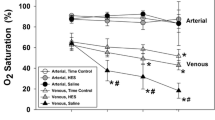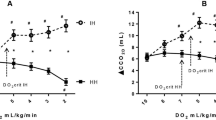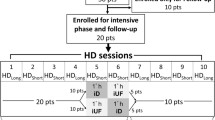Abstract
Theoretical deductions have shown that a shift of the blood O2 dissociation curve (ODC) to the right might improve O2 transport to tissues at normoxia and at mild hypoxia whereas at severe hypoxia the organism should be better off with an ODC shifted to the left (Turek et al., 1973b; Turek and Kreuzer, 1976). The present study was performed in order to ascertain this ambiguous effect of an ODC shift depending on the degree of hypoxia in intact animals. A major displacement of the ODC to the left was achieved in rats by chronic administration of sodium cyanate (NaOCN). Control animals received sodium chloride (NaCl) instead. Arterial and mixed-venous\(P_{{\text{O}}_{\text{2}} }\),\(P_{{\text{CO}}_{\text{2}} }\), and pH were measured at normoxia and during breathing 14.9, 8.0, or 5.6% O2 in N2 in both groups. From\(P_{{\text{O}}_{\text{2}} }\), pH, ODC and arterial hematocrit, arterial and mixed-venous O2 contents were estimated and\(({\text{a}} - {\text{v)}}_{{\text{O}}_{\text{2}} }\) as an index of blood O2 extraction was obtained. At normoxia and during breathing 14.9% O2 the NaOCN rats had a lower mixed-venous\(P_{{\text{O}}_{\text{2}} }\) than the NaCl rats without any difference in pH. Arterio-venous O2 difference did not differ at normoxia but was lower in NaOCN rats at 14.9% O2. However, at 8.0 and 5.6% O2 the NaOCN rats had a higher mixed-venous\(P_{{\text{O}}_{\text{2}} }\), an increased\(({\text{a}} - {\text{v)}}_{{\text{O}}_{\text{2}} }\), and a higher pH (arterial and mixed-venous). At 5.6% O2 the NaCl rats developed a severe acidosis concomitant with pronounced hypocapnia. These findings confirm that rats with a left-shifted ODC have an impaired O2 transport to tissues at normoxia and mild hypoxia but a more efficient O2 transport at severe hypoxia as compared with rats with an unshifted ODC, in agreement with our previous theoretical studies.
Similar content being viewed by others
References
Aste-Salazar, H., Hurtado, A.: The affinity of hemoglobin for oxygen at sea level and at high altitudes. Am. J. Physiol.142, 733–743 (1944)
Bakker, J. C.: 2,3-Diphosphoglycerate, Haemoglobin and O2 Release to Tissue (Ph. D. Thesis). Meppel: Krips Repro B. V. 1977
Bakker, J. C., Gortmaker, G. C., Vrolijk, A. C. M., Offerijns, F. G. J.: The influence of the position of the oxygen dissociation curve on oxygen-dependent functions of the isolated perfused rat liver. Pflügers Arch.362, 21–31 (1976)
Banchero, N., Grover, R. F., Will, J. A.: Oxygen transport in the llama (Lama glama). Respir. Physiol.13, 102–115 (1971)
Barcroft, J., Binger, C. A., Bock, A. V., Doggart, J. H., Forbes, H. S., Harrop, G., Meakins, J. C., Redfield, A. C.: VIII. —Observations upon the effect of high altitude on the physiological processes of the human body, carried out in the Peruvian Andes, chiefly at Cerro de Pasco. Philos. Trans. R. Soc. Lond. [B]211 351–480 (1923)
Barker, J. N.: Role of hemoglobin affinity and concentration in determining hypoxia tolerance of mammals during infancy, hypoxia, hyperoxia and irradiation. Am. J. Physiol.189, 281–289 (1957)
Bartels, H.: The biological significance of the Bohr effect. In: Oxygen Affinity of Hemoglobin and Red Cell Acid Base Status (M. Rørth, P. Astrup, eds.), pp. 717–735. Copenhagen: Munksgaard 1972
Baumann, R., Bauer, Ch., Bartels, H.: Influence of chronic and acute hypoxia on oxygen affinity and red cell 2,3 diphosphoglycerate of rats and guinea pigs. Respir. Physiol.11, 135–144 (1971)
Bullard, R. W., Broumand, C., Meyer, F. R.: Blood characteristics and volume in two rodents native to high altitude. J. Appl. Physiol.21, 994–998 (1966)
Cain, S. M.: Appearance of excess lactate in anesthetized dogs during anemic and hypoxic hypoxia. Am. J. Physiol.209, 604–610 (1965)
Chiodi, H.: Oxygen affinity of the hemoglobin of high altitude mammals. Acta Physiol. Lat.-Am.12, 208–209 (1962)
Chiodi, H.: Comparative study of the blood gas transport in high altitude and sea level camelidae and goats. Respir. Physiol.11, 84–93 (1970/71)
Duvelleroy, M. A., Mehmel, H., Laver, M. B.: Hemoglobin-oxygen equilibrium and coronary blood flow: and analog model. J. Appl. Physiol.35, 480–484 (1973)
Eaton, J. W., Skelton, T. D., Berger, E.: Survival at extreme altitude: protective effect of increased hemoglobin-oxygen affinity. Science183, 743–744 (1974)
Fletcher, J. E.: Some model results on hemoglobin kinetics and its relationship to oxygen transport in blood. In: Oxygen Transport to Tissue—II (J. Grote, D. Reneau, G. Thews, eds.). Adv. Exp. Med. Biol. Vol. 75, pp. 251–259. New York-London: Plenum Press 1976
Hall, F. G.: Minimal utilizable oxygen and the oxygen dissociation curve of blood of rodents. J. Appl. Physiol.21, 375–378 (1966)
Hall, F. G., Dill, D. B., Barron, E. S. G.: Comparative physiology in high altitudes. J. Cell Comp. Physiol.8, 301–313 (1936)
Kelman, G. R., Nunn, J. F.: Nomograms for correction of blood\({\text{P}}_{{\text{O}}_{\text{2}} }\),\({\text{P}}_{{\text{CO}}_{\text{2}} }\), pH, and base excess for time and temperature. J. Appl. Physiol.21, 1484–1490 (1966)
Kreuzer, F.: Transport of O2 and CO2 at altitude. In: Exercise at Altitude (R. Margaria, ed.), pp. 149–158. Amsterdam: Excerpta Medica Foundation 1967
Lahiri, S.: Blood oxygen affinity and alveolar ventilation in relation to body weight in mammals. Am. J. Physiol.229, 529–536 (1975)
Lenfant, C., Torrance, J., English, E., Finch, C. A., Reynafarje, C., Ramos, J., Faura, J.: Effect of altitude on oxygen binding by hemoglobin and on organic phosphate levels. J. Clin. Invest.47, 2652–2656 (1968)
Penney, D., Thomas, M.: Hematological alterations and response to acute hypobaric stress. J. Appl. Physiol.39, 1034–1037 (1975)
Roughton, F. J. W., Scholander, P. F.: Micro gasometric estimation of the blood gases. I. Oxygen. J. Biol. Chem.148, 541–550 (1943)
Ruggles, T. N., Lavietes, M. H., Miller, M., Woodward, H., Jr., Treister, M.: Effect of phenformin on the elevated blood lactic acid produced by hypoxia in normal and diabetic rats. Ann. N.Y. Acad. Sci.148, 662–670 (1968)
Snedecor, G. W., Cochran, W. G.: Statistical Methods. Ames, Iowa: Iowa University Press 1967)
Turek, Z., Kreuzer, F.: Effect of a shift of the oxygen dissociation curve on myocardial oxygenation at hypoxia. In: Oxygen Transport to Tissue—II (J. Grote, D. Reneau, G. Thews, eds.). Adv. Exp. Med. Biol. Vol. 75, pp. 657–662. New York-London: Plenum Press 1976
Turek, Z., Ringnalda B. E. M., Hoofd, L. J. C., Frans, A., Kreuzer, F.: Cardiac output, arterial and mixed-venous O2 saturation, and blood O2 dissociation curve in growing rats adapted to a simulated altitude of 3500 m. Pflügers Arch.335, 10–18 (1972)
Turek, Z., Grandtner, M., Ringnalda, B. E. M., Kreuzer, F.: Hypoxic pulmonary steady-state diffusing capacity for CO and cardiac output in rats born at a stimulated altitude of 3500 m. Pflügers Arch.340, 11–18 (1973a)
Turek, Z., Kreuzer, F., Hoofd, L. J. C.: Advantage or disadvantage of a decrease of blood oxygen affinity for tissue oxygen supply at hypoxia. A theoretical study comparing man and rat. Pflügers Arch.342, 185–197 (1973b)
Author information
Authors and Affiliations
Additional information
Preliminary communications of part of this material at the FASEB Meeting in Anaheim, California, on April 11–16, 1976 (Fed. Proc.35, 526, 1976), and at the Dutch Federation Meeting in Amsterdam on April 21–23, 1976 (Volume of Abstracts, p. 381)
Rights and permissions
About this article
Cite this article
Turek, Z., Kreuzer, F. & Ringnalda, B.E.M. Blood gases at several levels of oxygenation in rats with a left-shifted blood oxygen dissociation curve. Pflugers Arch. 376, 7–13 (1978). https://doi.org/10.1007/BF00585241
Received:
Issue Date:
DOI: https://doi.org/10.1007/BF00585241




